Cagliari: Sardinia’s capital a parade of colors and warmth

CAGLIARI, Italy – They came from all over the island, from the inland mountains to the seaside villages. They came from the far northern beaches where the Italian chic love to see and be seen and from apartments up the street where they drank Cannonau wine the night before.
They all came dressed in colorful costumes traditional on the island of Sardinia. There were the macellai, the butchers, in mustard-colored leather vests. There were the pescatori, the fishermen, who walked barefoot in white billowy trousers. There were the women dressed in long gowns and scarves and the rich women ladled in gold.
And so many colors. Purples and golds and reds and blues and greens. In the brilliant sun of a 70-degree spring day in the middle of the Tyrrhenian Sea, the parade looked like one long, walking rainbow.
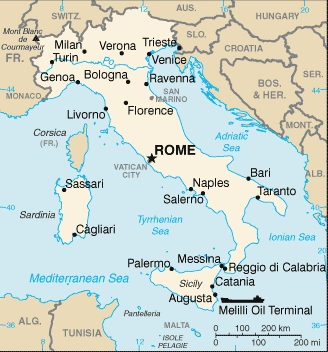
The history
Sunday was Sardinia’s biggest day, a day when the most fiercely independent people in Italy celebrate their very existence. The Festa di Sant’Efisio has been held every May 1-4 since 1656, the year when Sant’Efisio, the Patron Saint of Cagliari, the Sardinian capital, was credited for curing a bubonic plague that threatened to wipe out the island.
Marina and I came here over the weekend for a different celebration. It was the seven-year anniversary of our first date. After launching another season in the sun on a sandy beach, eating fresh seafood and seeing sunsets from a hip neighborhood atop a cliff, we can see why the Sardi packed Cagliari Sunday.
I don’t believe in miracles but, just to get in the Sardo spirit, I’ll say, Thanks, Efisio. You did well to save this city.
“I’m 32 years old,” said a woman standing next to me at the parade. “This is my 32nd time at this parade.”
Like many areas in the South of Italy, Sardinia has been picked apart through history by armies ranging from the Phoenicians to the Spanish. The Carthaginians. The Romans. The Pisans from Pisa. The Genoese from Genoa. The Aragonese from Spain. They all controlled this rich, strategically placed island until the early 1400s.
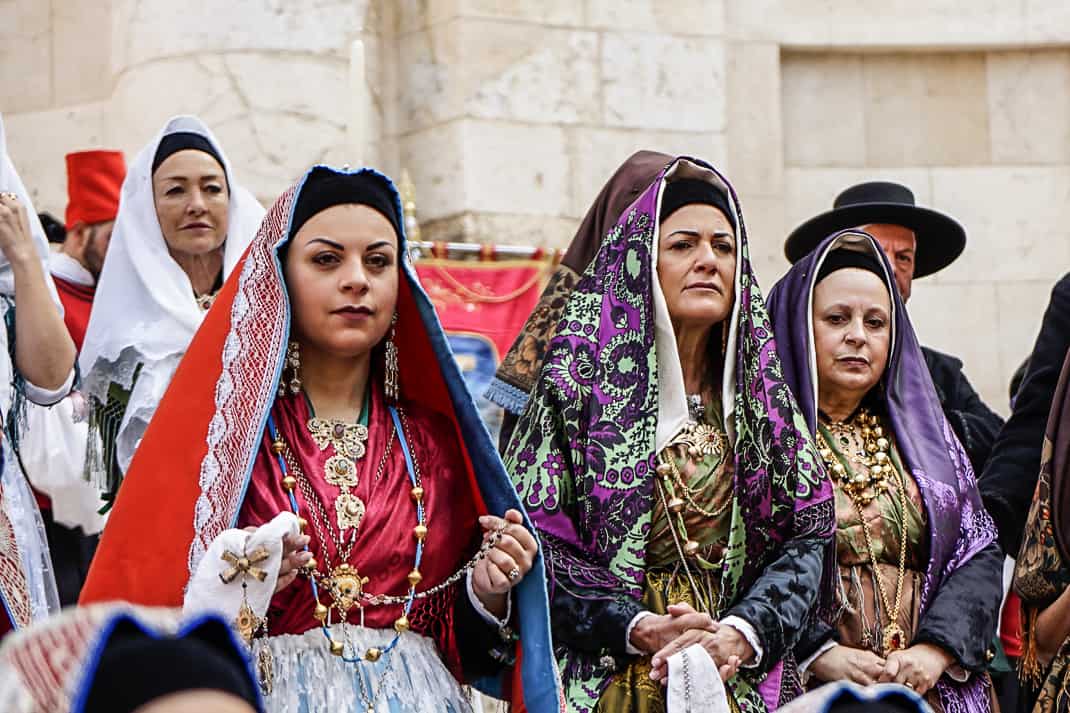
But it wasn’t until Sant’Efisio sent the plague packing did Sardinia stick around to stay. As the locals tell the story, in the 3rd century Efisio was a Roman commander from Jerusalem and was sent to Sardinia to stop the spread of Christianity.
However, instead of beating it, he joined it which didn’t go over well with his troops. They imprisoned him in Cagliari where he was skinned alive and burned with glowing embers then taken to the coastal town of Nora where he was beheaded. Before having his head lopped off, however, he vowed to protect Cagliari and its people.
In the 1650s, the plague had killed 10,000 people in Cagliari. According to legend, the viceroy count of Lemos saw Sant’Efisio in a vision in 1656 and asked the town to approve a procession carrying the saint’s statue on May 1 from Cagliari to Nora 38 kilometers (23 miles) away.
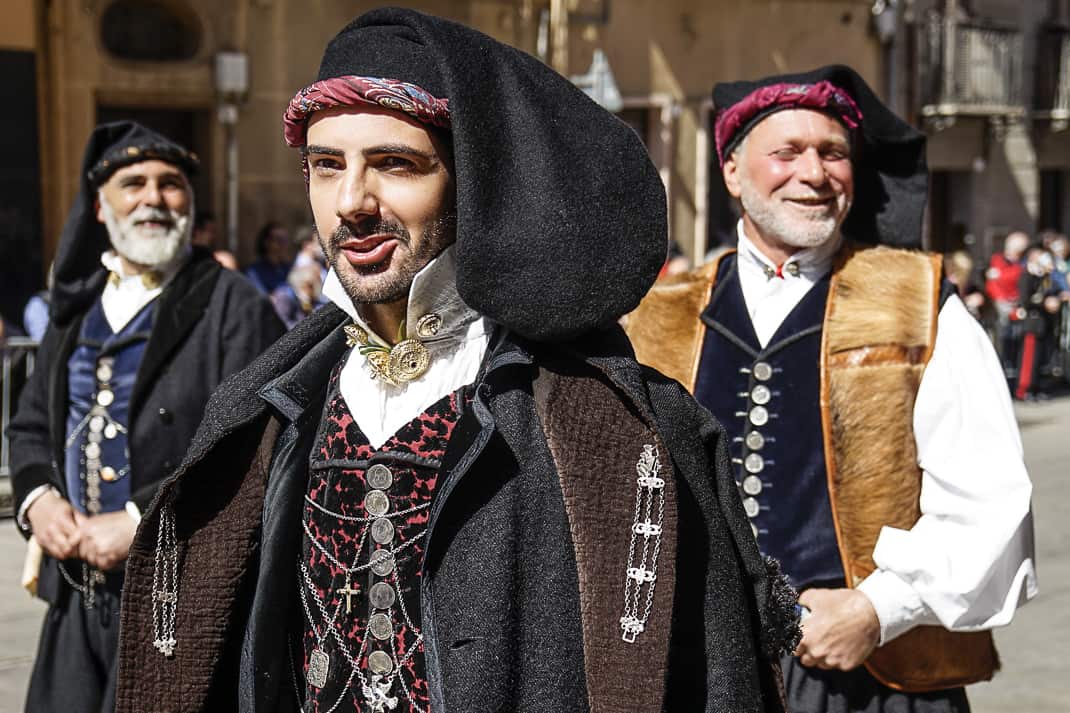
The rains came; the plague ended.
They’ve carried his statue to Nora every May 1 ever since.
The woman next to me wouldn’t give her name but she has one of the colorful costumes at home. These people don’t rent them. They’re owned. She usually walks in the procession and it takes her an hour to put on the outfit.
She said she started Sunday visiting Chiesa Sant’Efisio, the 18th century Baroque church around the corner and up the hill where the procession begins. She said goodbye to the statue before it left on its journey.
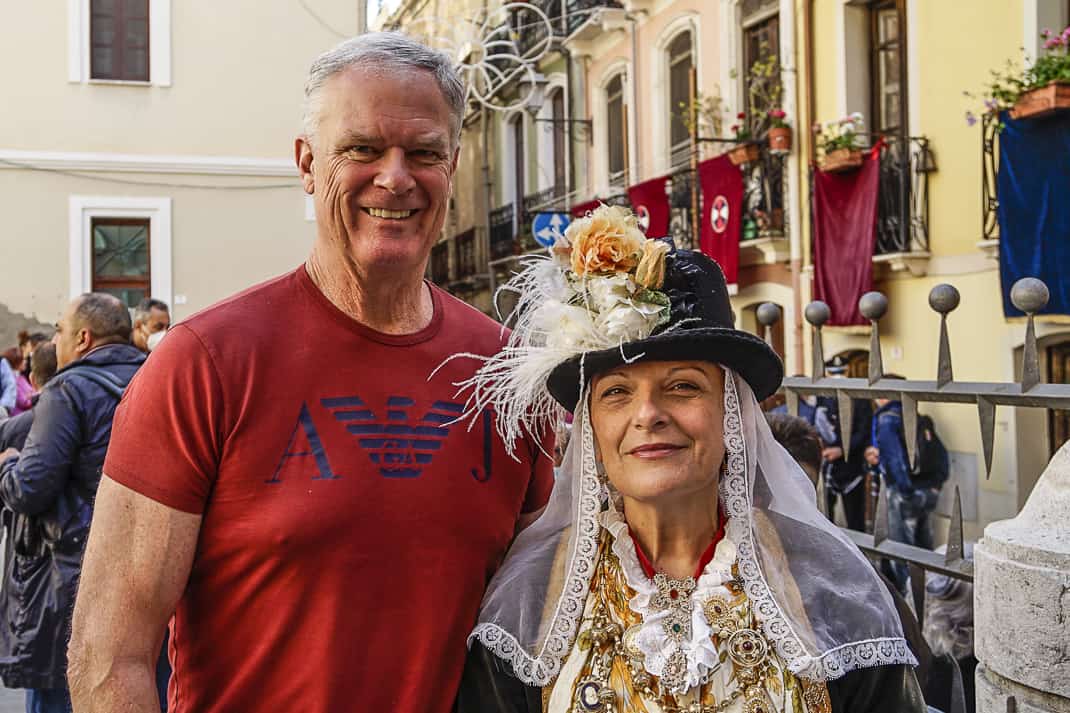
“My heart beats,” she said. “For people dressed in these special dresses, this is sort of a responsibility. It’s an engagement, a very serious matter.”
People in Northern Sardinia wake at 4 a.m. to make the trip. That explains why some of the babies the people carried in the parade looked dead as stuffed animals.
The parade began at 10 a.m. and continued for more than two hours. The parade alone was an absolute slow-moving wave of humanity: 2,788 people plus 288 on horseback from 81 associations representing 92 communities.

Men in black vests and black felt boots and long black hats marched past us as threesomes in red stove top hats played launeddas, Sardinia’s ancient, shrill-sounding instrument consisting of three long flute-like pipes tied together at one end. We looked up the street. The parade’s mass of humanity was still coming.
More than 35,000 people poured into this capital city of 154,000 to watch. Marina and I retreated to the packed piazza along the parade route for a pizza, nearing the end of a long, wonderful weekend in a very underrated Italian city that surprised us both.
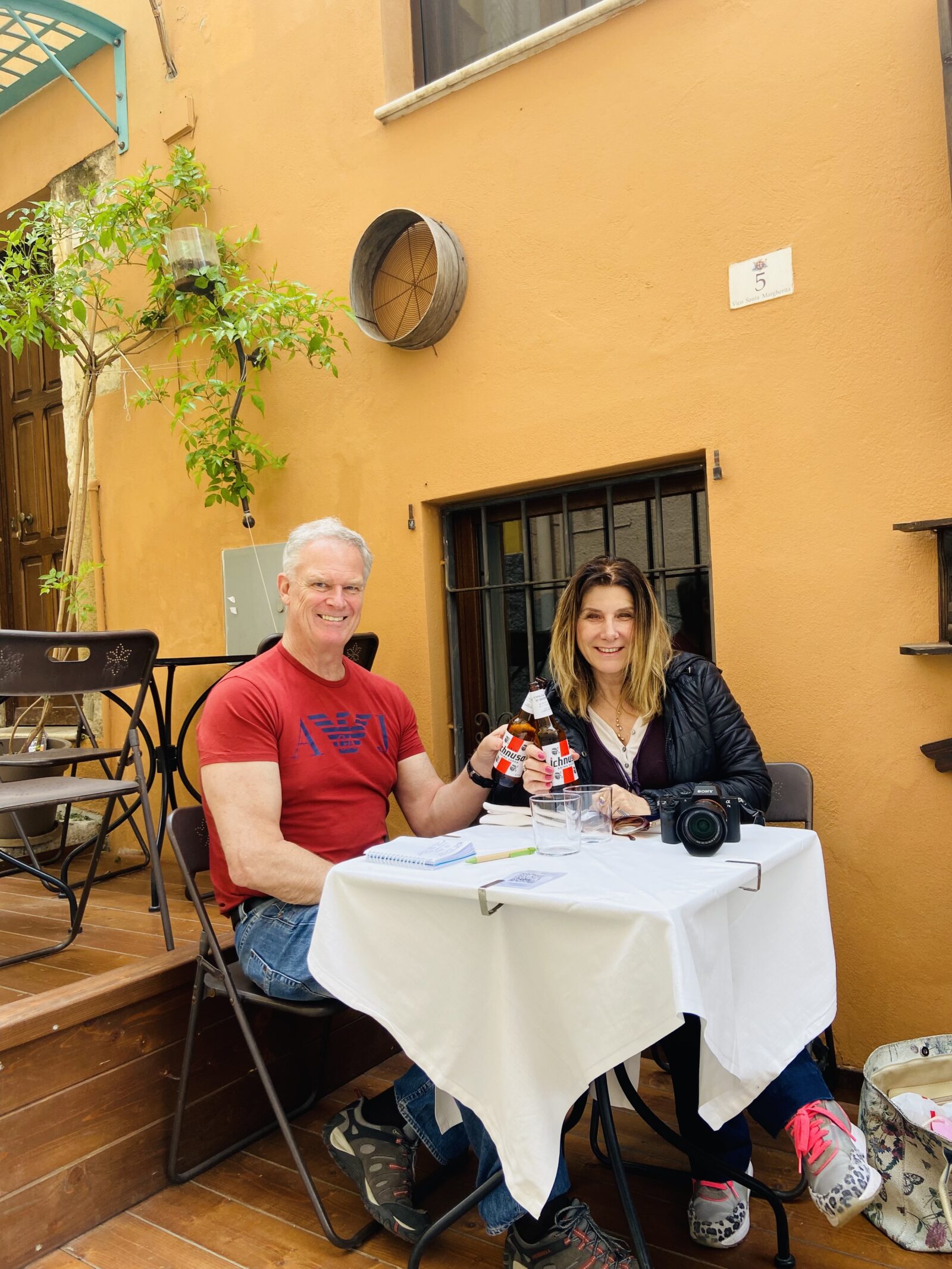
Cagliari the capital
I’d been to Sardinia before. When I lived in Rome the first time from 2001-03, I took the ferry, a converted low-end cruise ship, from the port city of Civitavecchia. I rented a car and hung out in Olbia, the gateway to hoity-toity Costa Smeralda. I cruised around Archipelago de Maddalena, sunbathed at Stintino which to this day is my favorite beach in Italy and prowled Alghero with as much Spanish trappings as many cities in Spain.
I saw the Nuraghe, the ancient megalithic buildings built between 1900-730 B.C. from Central Sardinia. I also visited the mountain town of Tiana, a remarkable place which at the time had 400 people and four were 100 years old. Just before I arrived, the oldest man in the world died there at 113.

But Cagliari is Sardinia’s capital. Its main square, Piazza Yenne, rocks with the romantic pulse of Paris in spring. Its historic center, Il Castello, is a sprawling neighborhood of narrow alleys between tall buildings and historic sites with panoramic views of the city below and sea and mountains beyond. Sandy beaches are a short bus ride away and restaurants serve a unique cuisine found nowhere else in Italy.
It’s the first time I’ve ever asked a waiter, “What wine do you recommend with donkey?”
Cagliari anchors the southern end of this island of 9,300 square miles, about the size of Vermont. We took an easy 50-minute flight from Rome and took a spacious room at LuxurYenne B&B right smack dab in the heart of Piazza Yenne. We could stumble out the door and pour ourselves into a half dozen bars.
Which I did.
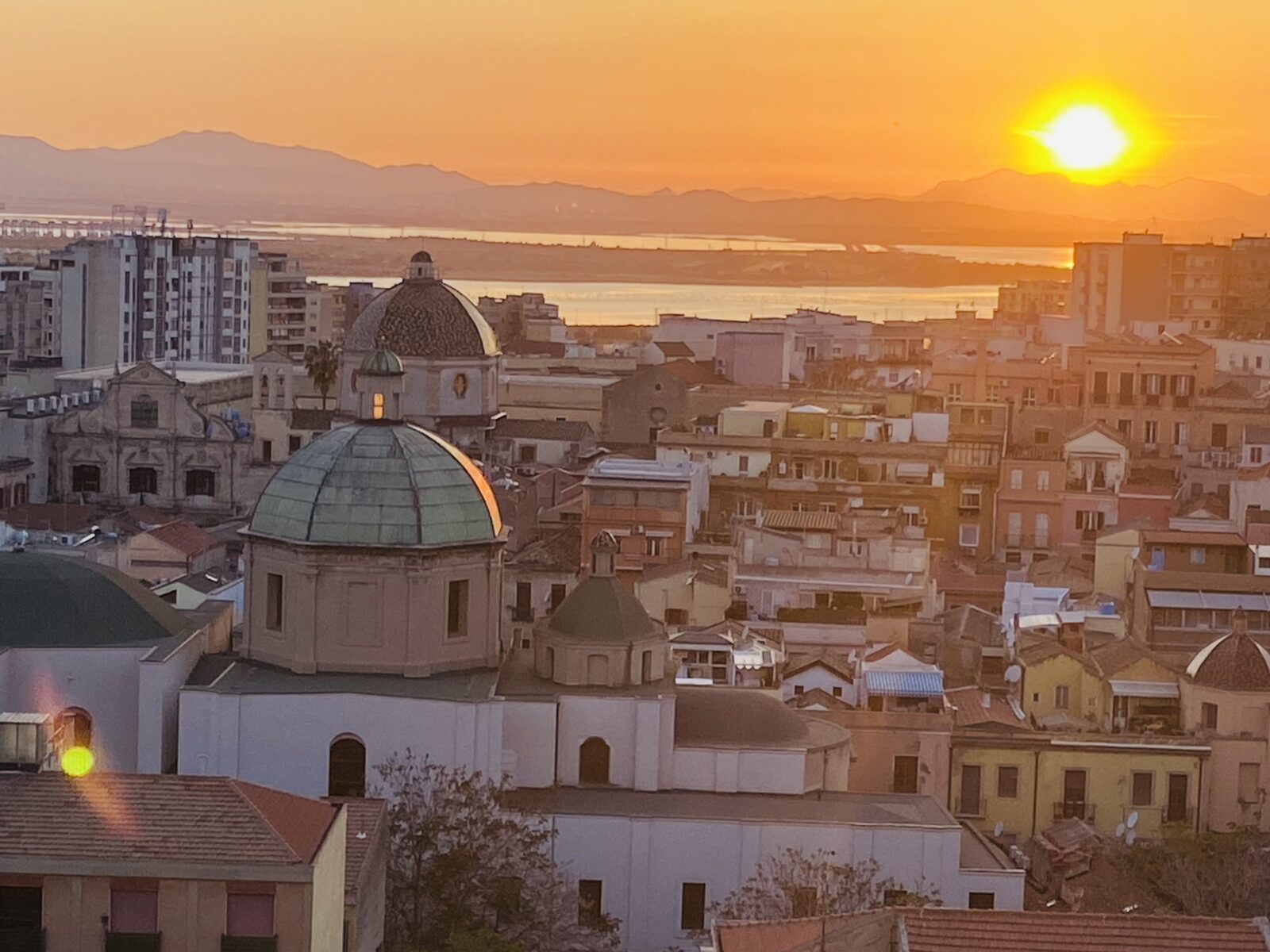
Il Castello
Translated, Cagliari’s Castello really isn’t a castle. It’s a neighborhood that hovers over the main town and features some of the ugliest parts of Cagliari history and some of its most beautiful parts of its present.
Marina and I walked out our door and almost immediately climbed about 100 steep steps. Looming over us stood a six-story, 42-meter tower of white stone, abandoned, in repair and eerie. It should. Torre dell’Elefante, one of only two Pisan towers still standing, was built in 1307 to hold off the Aragonese. It didn’t do too great of a job. The Spaniards used the tower to hang severed heads of the especially disobedient.
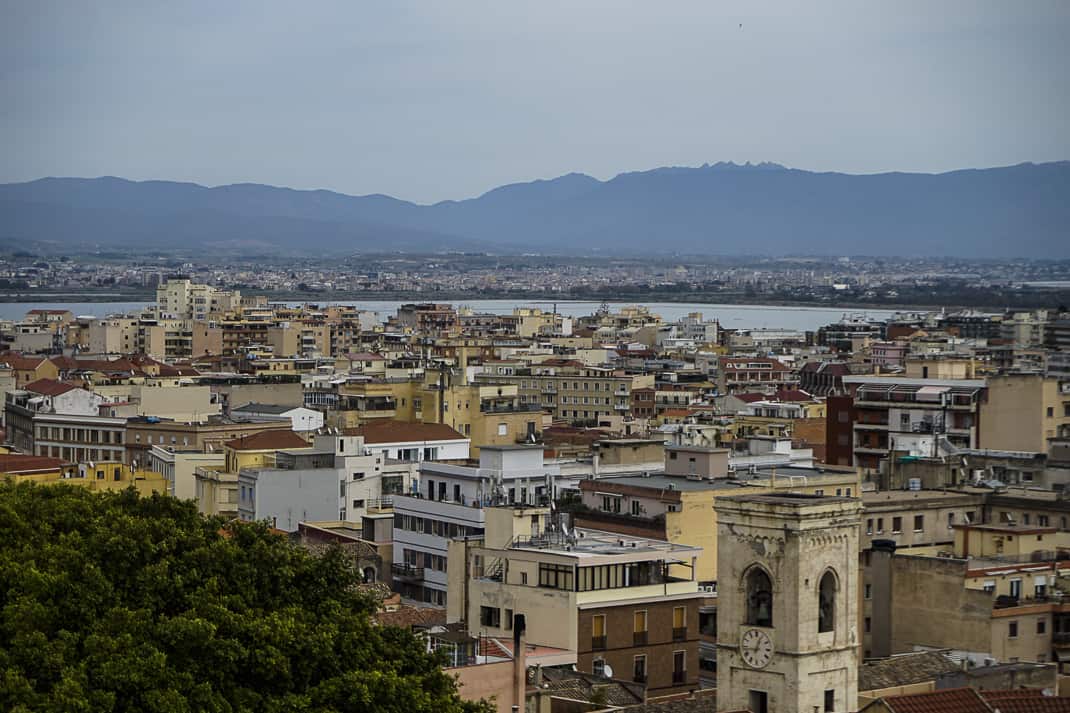
Too bad the dead heads couldn’t see. The view of the city below is spectacular. The sun was a fiery orange ball painting the landscape in various strips of orange, gold and yellow. Turquoise and copper domes of churches rose up from the red-tile roofs of the neighborhoods.
It’s even better up a level where the road is lined with upscale bars and restaurants. Each one has an outdoor viewing area decorated with umbrellas. Gazebos cover well-dressed professionals drinking brightly colored cocktails and Ichnusa, Sardinia’s trademark lager that’s sold all over Italy.
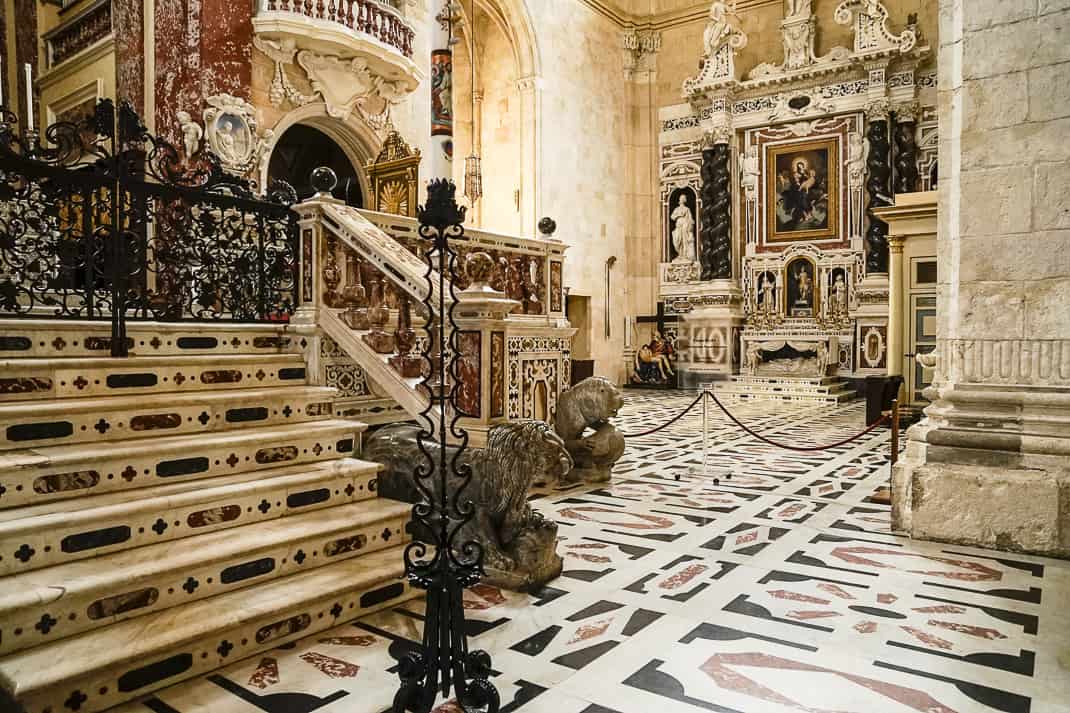
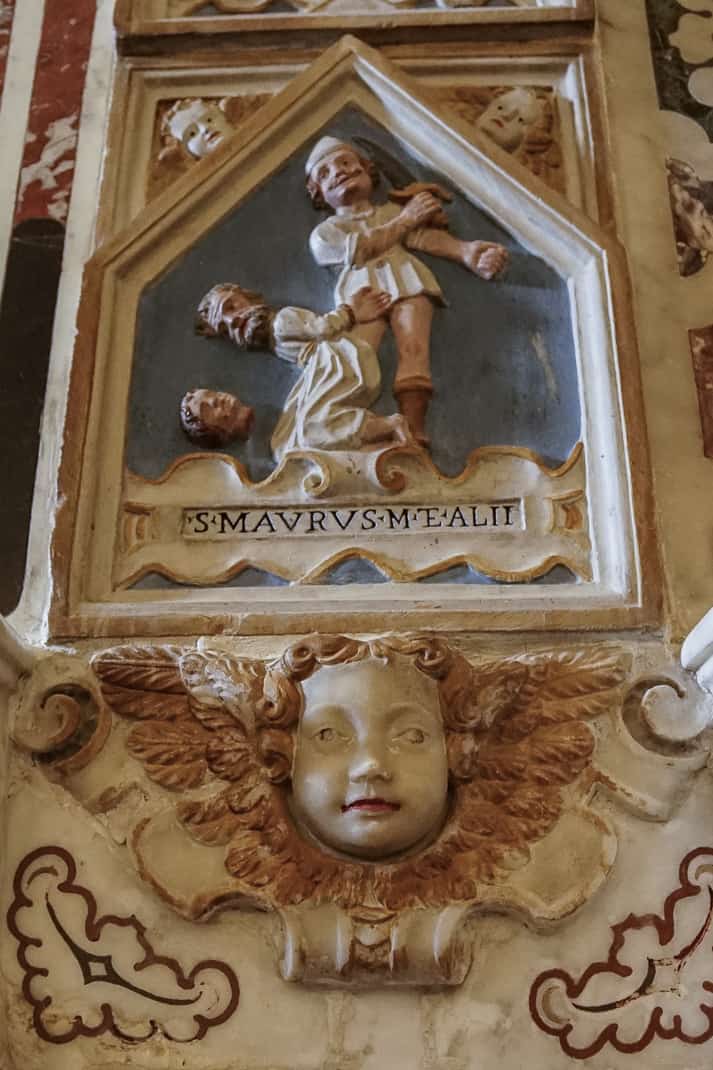
Dominating Il Castello is Cattedrale di Santa Maria, a 13th century church that has undergone major restoration. The outside is a mishmash of multi-century architecture. The inside is a cascade of white Baroque decor. The highlight is the Crypt, a sunken room with a barrel roof covering 584 unique circular decorations and 192 small niches adorned with martyrs in bas-relief.
Winding our way down another narrow road we came to Bastione di Saint Remy. It’s a huge terrace with panoramic views of the town, sea and mountains. Built between 1899 and 1902, it’s lit at night with 19th century street lights that make this possibly the most romantic 4,600 square meters (49,500 square feet) in Sardinia.
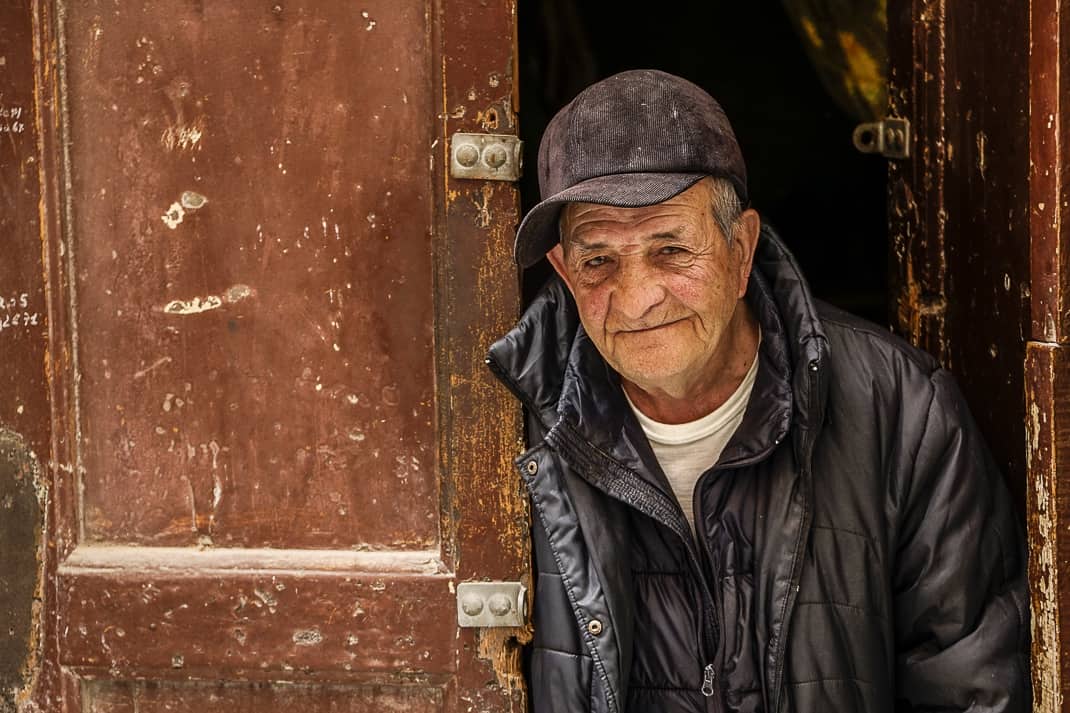
The Sardis’ remarkable longevity
The Sardi, strolling Saint Remy or sipping wine with million-euro views, know how to live. And they live long. The life expectancy in Sardinia, as of 2020, was 87 for women and 83 for men (It’s 83 overall in Italy and 79 for the United States.) Sardinia has 10 times per capita more centenarians, people 100 and older, than the U.S.
Demographers Michel Poulain and Gianni Pes even included Sardinia in their list of Blue Zones, areas where people naturally live longer than anywhere else in the world. (The others are Okinawa, Japan; Nicoya, Costa Rica; Ikaria island in Greece; and Loma Linda, Calif.)
Anthropologists have flocked to Sardinia to study the secrets. They say it’s due to its isolation and dependence on natural foods and wine, both in abundance locally, a lack of industrialization and a general low level of stress. Among Italy’s 20 regions, Sardinia’s crime rate ranks 17th.
That oldest man I cited above who died at 113?
Antonio Todde never left Sardinia. Not once. He spent 111 of his years in Tiana, only leaving for two years of military service in Cagliari during World War I.
While prowling the narrow alleys in Il Castello, Marina and I ran into an old man peering out of his workshop in a black worker’s cap. He said he’d lived on the street for 10 years and liked the quiet life in Sardinia. He was happy and smiling and welcoming.
We walked away and Marina, who’s known many Sardi before, said, “People from Sardinia are true people. They help you until they die. If you need something, they help you with passion. But if you betray them, they will kill you.”
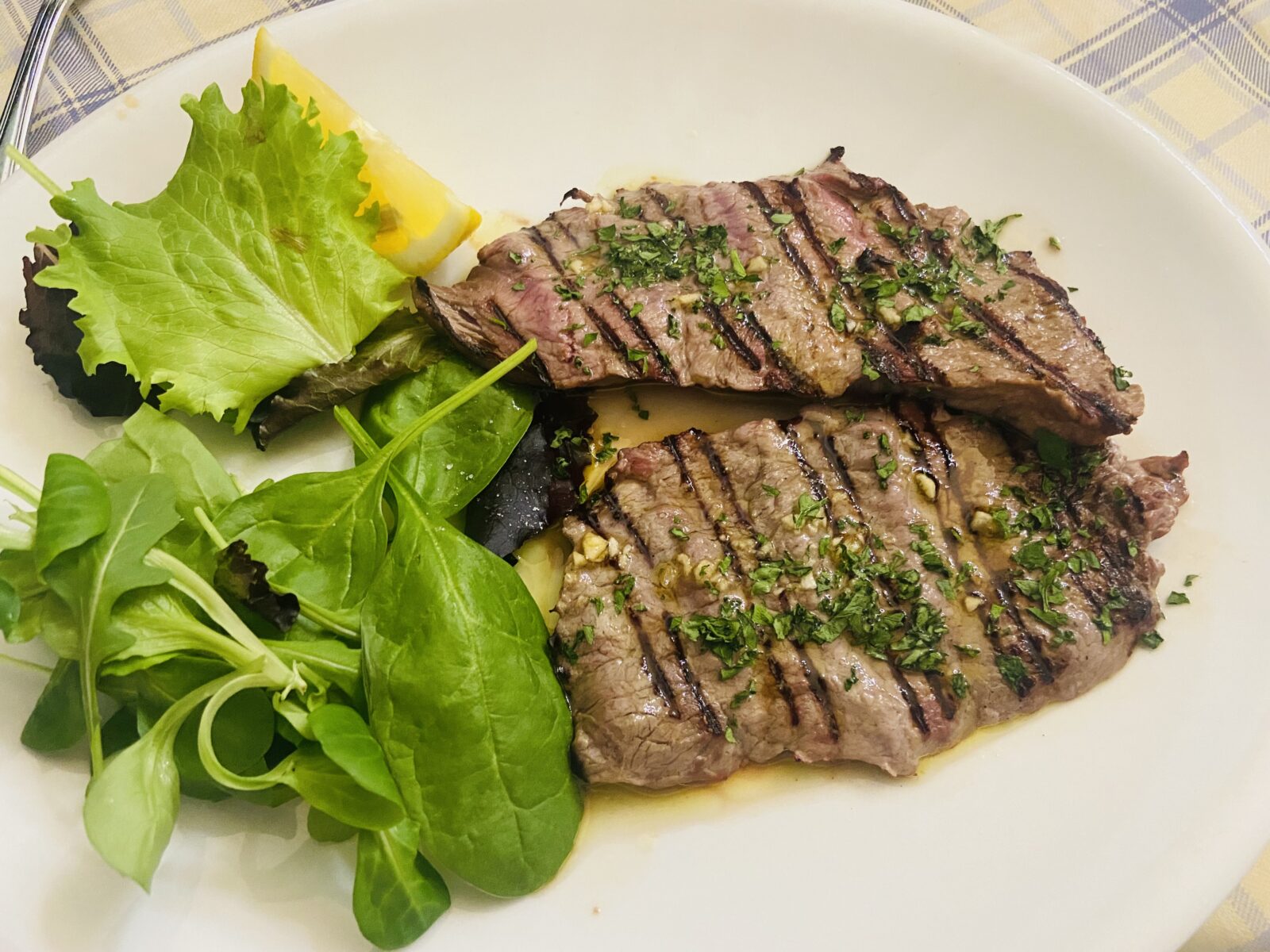
The food
Being a self-contained island, Sardi cuisine is unique and very fresh. And a bit weird. One of the biggest dishes is porceddu, Sardo dialect for suckling pig, flavored with rosemary. Roast baby goat is big and so is, ahem, horse. I had it on my first trip in the village of Marrubiu. No, it doesn’t taste like chicken. It tastes like a cheap steak.
But I’ve never had donkey, or asino in Italian or burriccu in Sardo. I had it at Pani e Casu, one of the restaurants with the outdoor tables looking out over a Van Gogh painting. The neoclassical building from the 18th century, coincidentally, was once an animal stable. Now instead of the animals eating there, they’re being eaten.
Yes, I did ask the waiter what wine goes best with donkey and he wasn’t surprised by the question. He said eats donkey all the time. In fact, I didn’t meet a Sardo who hadn’t. The answer is red wine and the Cannonau went well with the donkey, served in two small steaks, sprinkled with salt and parsley. It tasted like a very lean steak.
However, after eating the donkey I had an odd urge to carry luggage up a hill.
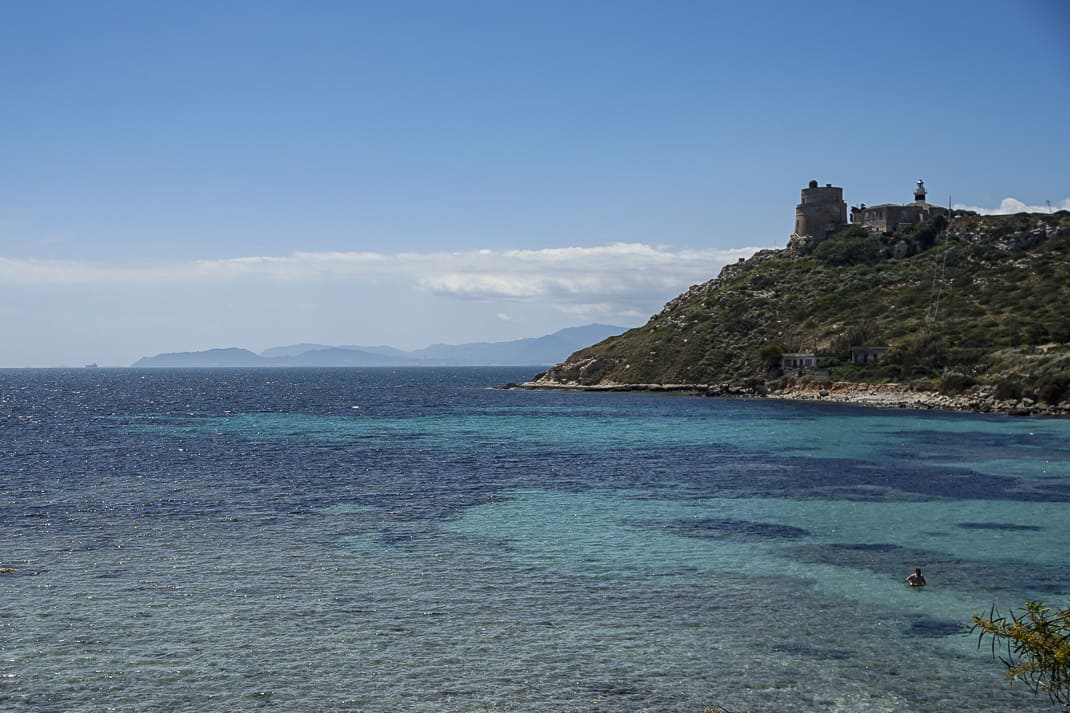
Seriously, Cagliari restaurants fit into the rest of Italy’s consistent gastronomic excellence. And then you add the views. We took a bus Saturday to Calamosca, a pretty, sandy beach on the outskirts of town. On the last day of April on a 72-degree day, it was about half filled and the first sun on my body felt like my first massage.
Above the beach is an elegant restaurant with over-the-top service. We ordered two drinks and two young women placed them down on separate trays like they were Ming vases. But the view of the sea was as good as my dish: plin ai due sapori, ravioli with Sardi sausage with lumpfish, eggs, local mushrooms called pioppini and lobster served in a lobster broth.
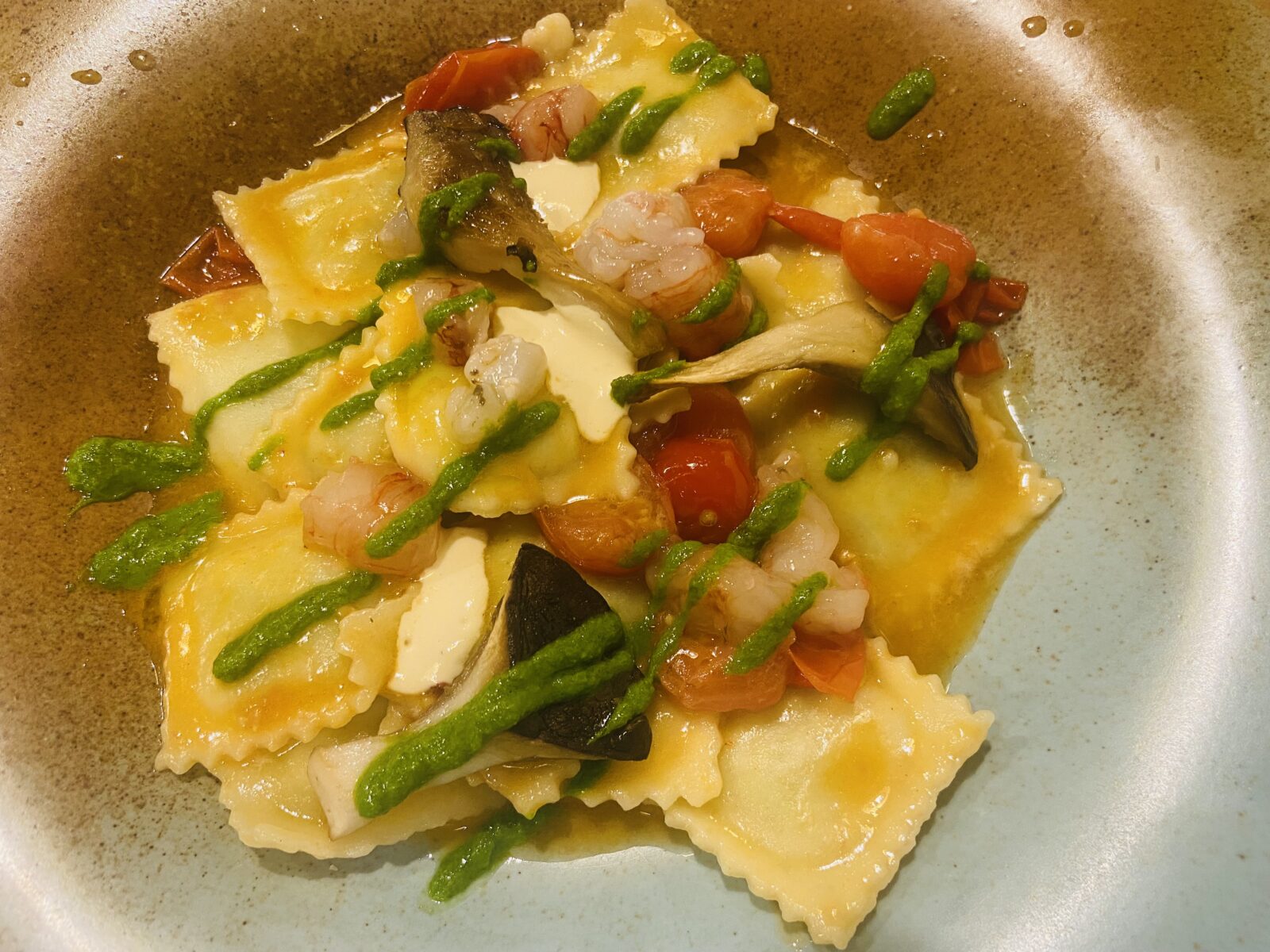
Maybe the top meal was at Is Femminas, recommended by my Sardo friend, Carlo, in my Rome neighborhood. It’s modern with op-art and black and white photos on the walls. I had the raviolini di ricotta, gambero rosso e cardoncelli, small ravioli in a red prawn bisque with raw ham and roasted mushrooms.
E’ BELLU MEDA! (Sardo for VERY GOOD!)
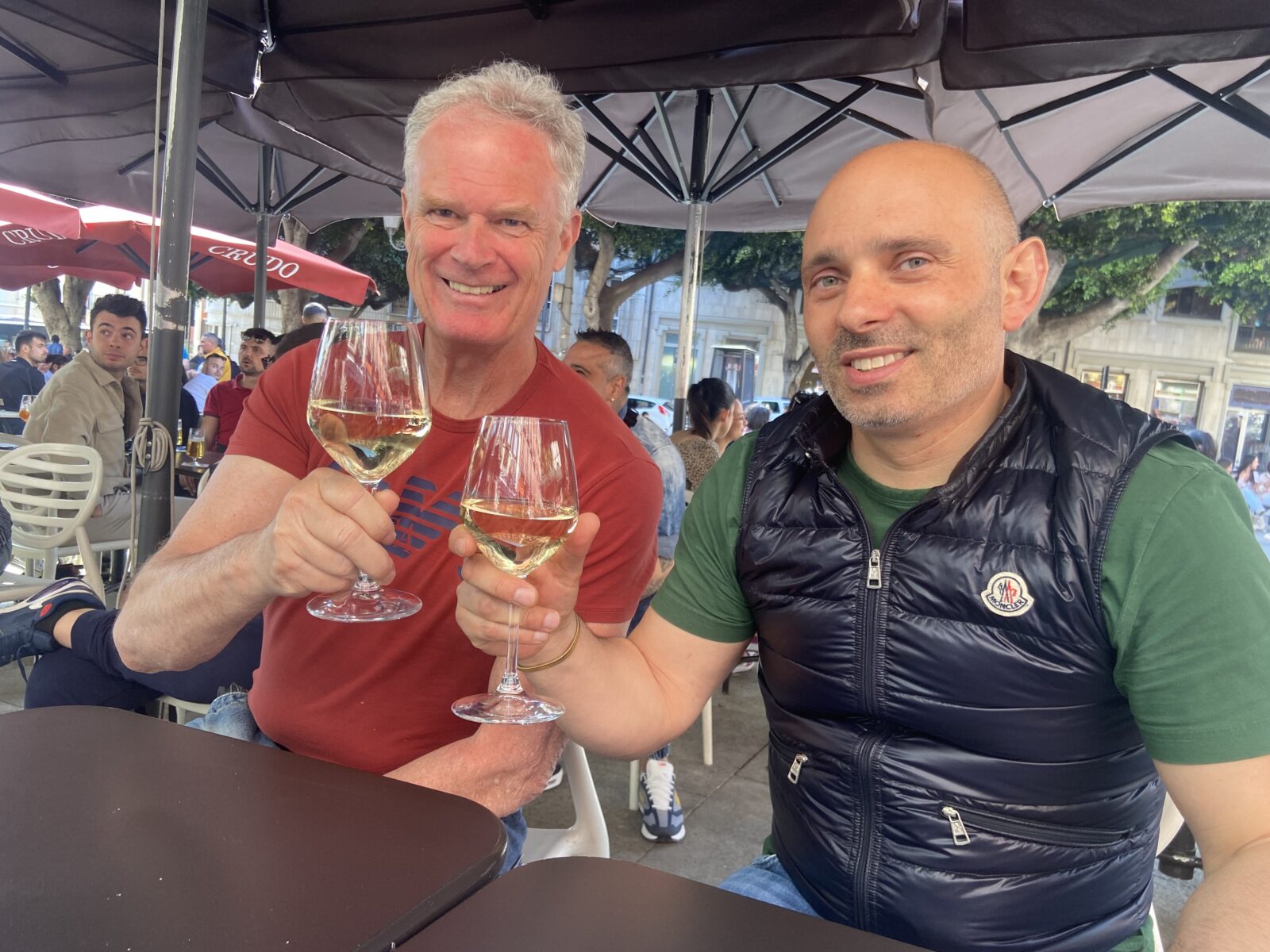
Sardo independence
We spent our afternoon following the parade drinking wine in the sun with Mauro Nonnis, the 43-year-old owner of LuxurYenneB&B. He comes from Seui, a village of about 1,500 70 kilometers (43 miles) north of Cagliari. He’s lived in the capital for 22 years and doesn’t sound like he’ll leave anytime soon.
“The city is the most beautiful in the Mediterranean,” he said. “Because of the sun, the sea. The people are very tranquil, very hospitable. You eat well. There are no thieves, no robberies, no crimes.”
Sardinia has changed. When I visited in 2002, the independence movement was still a topic of discussion. Sardo independence dates back to the 1920s and every decade would feature a wave of protests based on vanishing local culture. Some elections saw Sardo nationalist parties get 30 percent of the vote.
In the last 10 years, however, the movement has crumbled into loosely scattered organizations with no central policy. I asked Mauro about the status of independence. He scoffed.
“Independence would be impossible,” he said. “We have cheese, sheep and tourism.”
That’s it. But they also have a rich history, and never more historic than this week. On Tuesday, as you’re reading this, people are still filling the piazzas and the bars and the restaurants, gazing at sunsets with tall glasses in their hands.
On Wednesday, Sant’Efisio makes the journey from Nora back to Cagliari, entering the city at 10:30 p.m., with the lights of the city illuminating their hero. The city will then go to sleep, safe for another year.

In case you want to go …
How to get there: RyanAir and Volotea has hour–long flights from Rome starting at 53 euros round trip.
Where to stay: LuxurYenne B&B, Piazza Yenne 24, 39-380-367-9275, LuxurYenne – Location. Spacious room on first floor up from lively Piazza Yenne. I paid 184.50 euros for two nights.
Where to eat: Is Femminas, Via Napoli 90/92, 39-070-832-0183/080-332-8669, Is Femminas (facebook.com), isfemminas@gmail.com, 12:30-3 p.m., 7:30-10:45 p.m. Friday-Saturday, 8-11 p.m. Wednesday-Thursday, 1-3 p.m. Sunday. Excellent local seafood dishes starting at 15 euros.
Pani e Casu, Via S. Croce 51, 39-070-858-6629, paniecasucagliari@gmail.com, 1-3 p.m., 8:30-11 p.m. Tuesday-Sunday. Local specialties, including wild game meat, in 400-year-old building with outdoor seating overlooking city.
When to go: August temperatures range from 68-88 and January and February 42-58 with the most rain of six days. Our weekend at end of April was mid-50s to low 70s.
For more information: Tourist Office, Via Roma 145, 39-070-677-8173, www.cagliariturismo.it, 9 a.m.-8 p.m. April-October, 10 a.m.-1 p.m., 2-6 p.m. Monday-Saturday, 10 a.m.-1 p.m. Sunday November-March.

